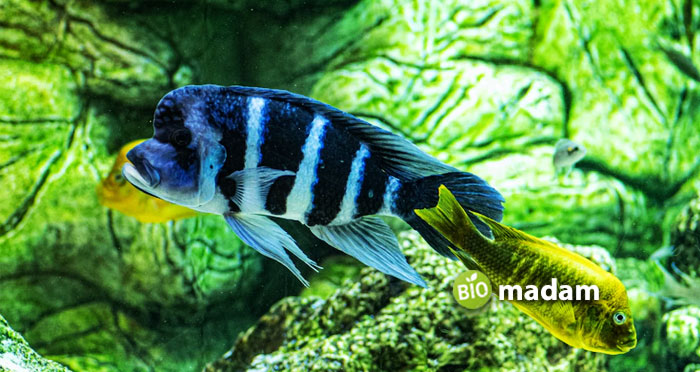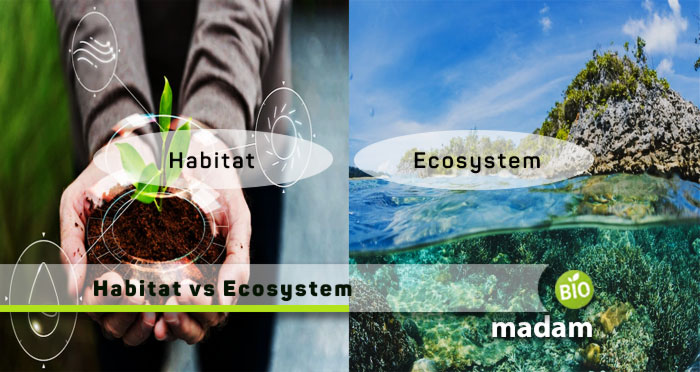Habitats, communities, and ecosystems together make up the landscape and contribute to numerous types of ecology. Habitat refers to an area where an organism lives. On the other hand, an ecosystem comprises various habitats of different organisms in a specific region. Various organisms, including microorganisms, plants, animals, and fungi, interact with the nonliving factors in an ecosystem.
Let’s tell you all the differences between habitat and ecosystem.
Comparison Table
| Characteristics | Habitat | Ecosystem |
| Definition | Location of an organism | Living and non-living components |
| Size | Small | Large |
| Relation | Part of ecosystem | Comprises many habitats |
| Species | A few | Many |
| Types | Forests, deserts, mountains, aquatic | Terrestrial and aquatic |
| Trophic Level | Few | All |
| Environmental Conditions | Relevant to specific species | Suitable for all populations |
What is a Habitat?
Habitat is defined as the ecological area in which an organism lives.
Habitats determine the distribution of one type of organism that makes up a population. They are surplus in all natural resources a population requires to survive and reproduce. As the population of a particular organism increases, all the individuals residing in the same habitat.
Different types of eukaryotic and prokaryotic organisms live in specific habitats. For example, fishes live in oceans and lakes depending on their need for freshwater or marine nutrients. On the other hand, some insects may harm their habitat by acting as pests.
Habitats are generally occupied by organisms naturally. However, sometimes they may live in artificial or man-built habitats. The drawback of a natural habitat is the presence of predators in surrounding areas.

Types of Habitat
As all organisms have varying needs, they live in different habitats. Thus, habitats are categorized according to the type of area and resources for the population.
Forest Habitat
Forests are large areas of land covered with plants and other green elements, including fungi, moss, and algae. Forests are of three kinds:
- Tropical forest or tropical rainforest
- Temperate forest
- Boreal or Taiga forests
Tropical forests are between the equator and the tropic of Cancer and Capricorn. The plants in these forests tolerate a temperature between 20 and 34 degrees Celsius. These regions receive surplus rainfall annually of over 200 cm. Orchids, moss, ferns, and vines are found in these forests. They are a habitat for monkeys, gorillas, bats, sloths, and many insects.
Temperate forests have a wide range of temperatures between -30 degrees Celsius and 30 degrees Celsius. They receive less than 150 cm of rainfall throughout the year. Temperate forests are in North America, Europe, and Northeast Asia. They are home to mountain lions, black bears, and fox bald eagles.
Alternatively, Boreal forests may tolerate temperatures as low as 50 degrees Celsius to as high as 30 degrees Celsius. They comprise various plants, including fir and pine. Deer, wolves, foxes, and chipmunks live in these areas.
Grassland Habitat
Grassland habitats have different species of grasses, bushes, shrubs, and trees. These areas have low rainfall, between 50 and 90 cm, and temperatures from -20 degrees Celsius to -30 degrees Celsius. Grasslands are favorite habitats for deer, giraffes, lions, zebra, and elephants.
Desert Habitat
Deserts are areas with little to no rainfall below 25 cm annually. Daytime temperatures in summer may reach up to 45 degrees Celsius. On the other hand, some deserts, like the Gobi desert in China, are incredibly cold. Sahara, Thar, and Kalahari deserts are hot deserts. Deserts are home to cacti, kangaroo rats, and camels.
Aquatic Habitat
The other kind of habitat is aquatic habitats that include all water bodies like seas, lakes, rivers, and oceans. Aquatic habitats are also categorized into freshwater, coastal, and marine. The organisms living in these habitats are also named according to the habitats.
- Fish, ducks, water lilies, and lotus are freshwater organisms and live in rivers, lakes, and ponds.
- Whales, sharks, jellyfish, and seaweeds reside in oceans that make the marine water habitat.
- Clams, crabs, kelp, shrimps, prawns, and seabirds belong to coastal habitats like mangroves, coral reefs, and seagrass meadows.
Mountains
Mountains and polar regions are the coldest habitats on Earth. They include the Antarctic and Arctic regions. The temperatures in these areas may fall as low as -88 degrees Celsius. Polar regions are home to polar bears, seals, and penguins.
Now that you know the types of habitats of different populations, let’s tell you about ecosystems for a better understanding.
What is an Ecosystem?
Ecosystem refers to the interaction between different populations and the non-living components in an area.
The word “ecosystem” was used by A.G.Tansley, an English botanist, in 1935. Ecosystems are the structural and functional units of different types of ecologies characterized by the interactions between organisms and their environment.
Ecosystems may contain various kinds of organisms living in a particular space. The size of an ecosystem may vary from a fish tank with plants and different fishes to forests comprising multiple components.
Ecosystems have numerous organisms involved in food chains and food webs besides the non-living elements. These communities collectively use the resources in the surroundings to create an ecosystem.

Types of Ecosystems
Like habitats, ecosystems are also of different kinds, comprising various living and non-living organisms. Multiple ecosystems make up biomes depending on the contributing factors. Let’s tell you about the types of ecosystems:
Terrestrial Ecosystem
Terrestrial ecosystems are land-based ecosystems having different species of animals, plants, algae, and fungi. They comprise other land areas, including forests, grasslands, and deserts. All these ecosystems are present in different regions on Earth.
Forests have hundreds of different types of trees, shrubs and grounds covers. Tundra ecosystems also have trees, but they possess low temperatures. These trees are typically covered with snow through a large part of the year.
Moreover, grassland and desert ecosystems are also habitats for various animals that do not require a lot of rainfall for survival. Grassland ecosystems are covered with several unique types of leaves and grasses primarily. On the contrary, deserts do not have much vegetation, and cactus is the most common plant.
Aquatic Ecosystem
Aquatic ecosystems may be marine or saltwater, depending on the water body the organisms live in. Freshwater ecosystems include ponds, lakes, rivers, and streams without salt content. On the other hand, marine ecosystems have a significant salt content and offer more types of biodiversity than freshwater. Seas and oceans are marine ecosystems.
Difference between Habitat and Ecosystem
Definition
Habitat
Habitat refers to the natural home of an organism where an individual or a population lives.
Ecosystem
Ecosystems comprise different communities and interact with each other and the surroundings.
Size
Habitat
A habitat is smaller than an ecosystem surrounding a population living in an area.
Ecosystem
Alternatively, ecosystems may be small or large but contain various living and nonliving components.
Correlation
Habitat
Habitat lies within an ecosystem and acts as one of many elements.
Ecosystem
On the contrary, ecosystems may contain various habitats along with non-living components.
Species
Habitat
Habitats comprise different niches, where one is the prominent population, along with a few other species.
Ecosystem
At the same time, ecosystems may have large numbers of species from different genera, depending on the size of the ecosystem.
Types
Habitats
Habitats are divided into five types: forests, deserts, grasslands, mountains, and aquatic habitats.
Ecosystems
Ecosystems are classified into terrestrial and aquatic ecosystems with further divisions.
Trophic Levels
Habitat
Habitats comprise a few trophic levels only.
Ecosystem
On the other hand, ecosystems contain all the trophic levels.
Environmental Condition
Habitat
The habitat for each organism varies, having different natural resources like sunlight, soil, etc.
Ecosystem
The environmental conditions for all organisms in an ecosystem are the same.
The Bottom Line
Habitats and ecosystems are important components of biomes and biospheres to study the behavior of organisms. They allow biologists to study the different branches of biology by understanding the relationships between populations and their surroundings. Habitat refers to the natural location of an organism or population. In comparison, ecosystems comprise living and nonliving organisms in an area. Thus, ecosystems contain multiple habitats of organisms, including animals, plants, algae, fungi, and mold. They also give information regarding their interaction with the environment.
FAQs
What is an example of an ecosystem?
An ecosystem constitutes organisms living together and interacting with the nonliving surrounding elements. So, any space around you with different animals, insects, and plants can be an example of an ecosystem.
What is the relationship between a habitat and an ecosystem?
A habitat refers to the place where an organism lives, and an ecosystem can be a habitat for multiple organisms. Every habitat has an ecosystem that helps the organisms survive.
What is a similarity between a habitat and an ecosystem?
Habitat and ecosystem are areas where an organism lives. An organism might have a habitat where no other species lives. However, sometimes multiple organisms have the same habitat, forming an ecosystem.
Which ecosystem do most animals live in?
The Amazon is the largest terrestrial ecosystem on Earth, with over 30 percent of the total global species found there.
Is planet an ecosystem?
The Earth is a large ecosystem with multiple species living together and interacting with their environment. The planet contains various other ecosystems within the large ecosystem.
What is the biggest habitat?
The deep sea habitat is the biggest habitat on Earth, covering 71% of the total Earth’s surface. The deep sea covers 53% of the sea’s surface and is over 4000 meters deep.

Jeannie has achieved her Master’s degree in science and technology and is further pursuing a Ph.D. She desires to provide you the validated knowledge about science, technology, and the environment through writing articles.

